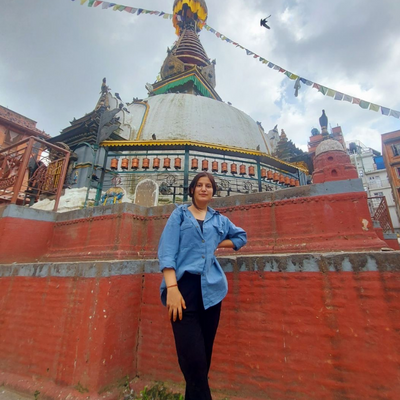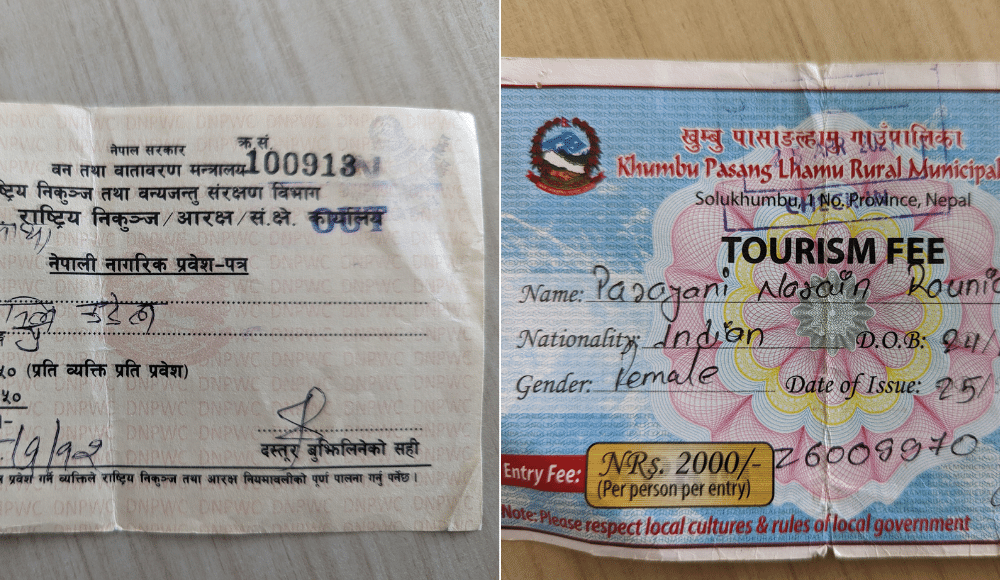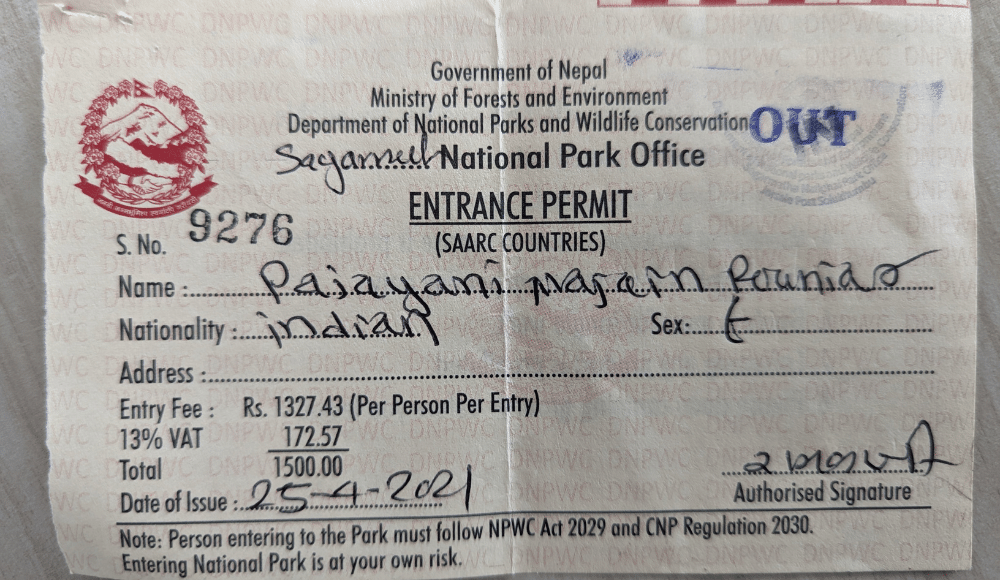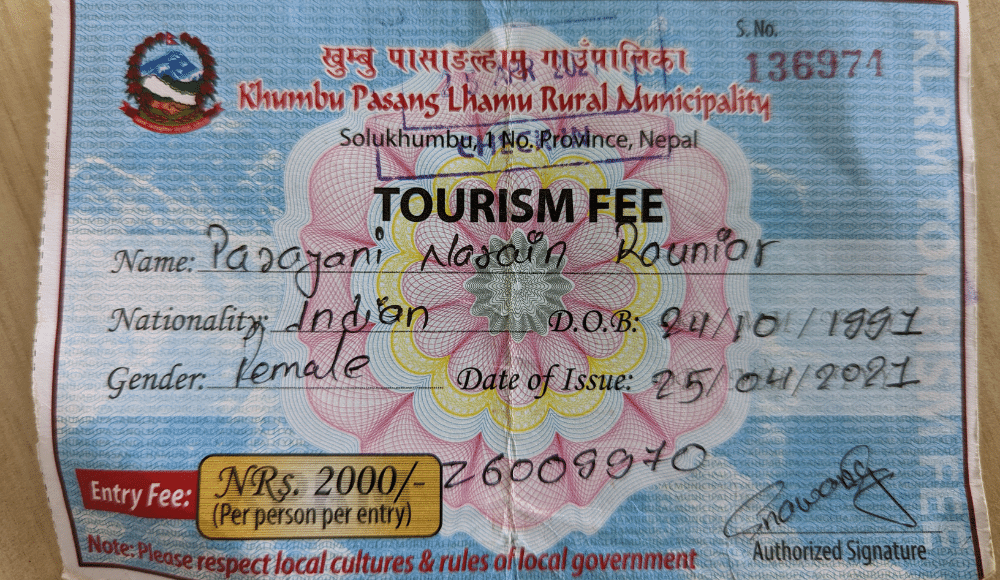Everest Base Camp Trek Permits
There are two permits required for the Everest base camp trek. One of which is a Sagarmatha national park permit and another one is a Khumbu Pasang Lhamu municipality entrance permit.
There are two permits required for the Everest base camp trek. One of which is a Sagarmatha national park permit and another one is a Khumbu Pasang Lhamu municipality entrance permit.


Everest base camp lies within the territory of Sagarmatha National park which is located in the northeast region of Nepal, the Khumbu region. Sagarmatha national park has many attractions and features. One of which is the Everest base camp trek. Everest base camp trek is widely popular for trekking and every year thousands of visitors visit this region. Trekking to the Everest base camp requires different permits. These permits vary by the national park and local rural municipality. So for the Everest base camp trek, two permits are required. One of the permits is the national park permit generated by the government, and another one is the activity permit generated by the Khumbu Pasang Lhamu municipality.
Everest base camp trek is fun and adventurous, preferred by many. The trek includes slippery terrains and barrens with various geographical features such as glaciers, landscapes, rivers, lakes, and so on. During the trek, you can observe several mesmerising floras and faunas which enchant the visitors. The trek to Everest base camp is moderate to strenuous along with an amazing experience. Here, You can also enjoy camping along with your friends on the scenic lap of the great Everest.
Trek to Everest base camp is indeed a pleasant surprise for the real adventure seeker. The trails up to Tengboche are quite simple and easy and the trekkers will only get excited to reach the summit of base camp. But after Tengboche the real hell starts, the altitude sickness starts to kick in and the real thrill begins. To reach the summit you must practice acclimatising, hike for some distance, increase your stamina, and boost your physical fitness before going for the peak. Though the trek is astonishing and you will receive immense pleasure during the trek, you have to make yourself fit and comfortable around the thin air in that range.
There are two permits required for the Everest base camp trek. One of which is a Sagarmatha national park permit and another one is a Khumbu Pasang Lhamu municipality entrance permit. You need to get these permits before you hop on the trek. A national park permit can be purchased from various places and you can have many options. But for the Municipality permit, there are only some specific areas you will get it from. So before going on the trek make sure you have the necessary permits.
|
Trek |
Everest Base Camp Trek |
|
Elevation |
5364m. |
|
Location |
Solukhumbu District (Khumbu Region) |
|
Starting Point |
Lukla |
|
Ending Point |
Lukla |
|
Distance from Lukla |
37.2 KM |
|
Trek type |
Moderate to Strenuous |
|
Major Attractions |
|
|
Permits |
|
Everest base camp is one alluring feature of Sagarmatha national park which lies at the elevation of 5364m. Geographically, it lies in the eastern development region, province no.1, Solukhumbu district. It is located within Sagarmatha national park which is known as the land of the mighty Everest. Also, commonly called the roof of the world. Everest base camp is a popular trekking site containing jaw-dropping, delightful, and marvellous views and geological features of Sagarmatha national park.
The snow-capped high Himalayans surrounding this national park provide quite a sight to immerse. Everest base camp sits just on the lap of these majestic peaks and beholds its beauty. There are two base camps designated for the great Everest. One is the south base camp and the other one is the north base camp. The south base camp lies in the southern region of Everest in the country of the great Himalayans, Nepal.
Everest south base camp can be reached from Lukla. The trails to reach Everest base camp follow Lukla, Phakding, Namche Bazaar, Tengboche, Dingboche, Lobuche, Gorak Shep, and the summit. One of the fascinating aspects of the Everest base camp is, you can enjoy the spectacular sight of the Everest region but you cannot view Everest from the base camp.
Everest base camp treks actual thrill kicks in after reaching Tengboche. The thin air range starts from here and the trekkers start to feel altitude sickness. After some more hikes above Lobuche, there is Gorak Shep, a small sherpa village that has two routes separating the Everest Base camp trek and the Kalapathar trek. Most of the visitors go to Everest base camp on an early morning trek, get back to Gorakshep after some visit and hike to Kalapathar for the amazing Everest view.
Related Read: Where is Mount Everest Located?
Everest base camp can be reached by air or drive. Through the air, you have two possible options: Flight and Heli ride. The best approach is the flight to Lukla from the capital Kathmandu which takes about 30 min. After the flight, you have to trek about 37.2km which follows the route as Lukla to Phakding, Phakding to Namche Bazar, Namche Bazaar to Tengboche, Tengboche to Dingboche, Dingboche to Lobuche, Lobuche to Gorak Shep and Gorakshep to Everest Base Camp.
Not only through Lukla flight, but you can also reach there through a heli ride which basically includes an aerial view without having to trek. You can directly reach the Everest base camp through this. This is a luxury ride and you can enjoy the panoramic view of Everest through this. Only 4 to 5 individuals are allowed on one ride.
Alternative to air there is drive. You can drive from Kathmandu to Salleri and then start your trek from there up to the base camp which takes about 4 to 5 days. This is the new trail accompanied by many trekkers whereas there are many traditional routes. One of which is the drive from Kathmandu to Jiri and trek for about 10 days. This will lead to the destination, Everest Base camp. You can choose the trail on your own availability.
Two permits are required for the Everest base camp trek.
|
Required Permits |
|
1. Sagarmatha National Park Permit |
|
2. Khumbu Pasang Lhamu Rural Municipality Entrance Permit |
A brief description of these permits is discussed below.
This is the permit generated by the National life and Wildlife Conservation Department. These are the permits required just to enter the park. You can get these permits from various sources. Various resources don't mean you can randomly purchase them from random vendors, it has to be authorized. Normally you can get this from the visitor centre office which is in Lukla, Monjo, and Namche Bazaar.

Sagarmatha National Park Permit Costs:
|
Nationals |
Permit Cost (with 13% VAT included) |
|
Nepalese National |
NPR 100 |
|
SAARC National |
NPR 1500 |
|
Foreign National |
NPR 3000 |
Also, there is this provision in which you can get these permits from the Department of the national park and wildlife Conservation centre, Bhrikutimandap Kathmandu. Generally, most visitors take their National park permit from the DNPWC, Bhrikutimandap as it is easy and accessible. If you forget to take your permit from Kathmandu you can easily get it from the above-mentioned places. The cost of this permit varies according to country. For the SAARC nationals, it is Rs 1500 and for the foreign nationals, it is Rs 3000.
It is an additional permit required for the Everest base camp trek. This is generated by the Pasang Lhamu municipality. Not only for trekking it is necessary for every activity that you conduct inside the national park. Such as hiking, mountaineering, heli-ride, mountain flight, and so on. Unlike SNP permits, this permit can only be purchased from Pasang Lhamu Rural Municipality, Khumbu. It is the same for all nations with the cost of Rs. 2000.

Khumbu Pasang Lhamu Rural Municipality Permit Cost:
|
Nationals |
Permit Cost (with 13% VAT included) |
|
ALL National (Except Nepali) |
Rs. 2000 |
Notes: A new implementation has been done. i.e Khumbu Trek card has been digitised. You can scan or tap the card to know more about it.
If you plan to visit the Everest base camp, then you must get this permit. Recently there have been some changes in this permit which is, it has been digitalized and known as Khumbu digital trek card. The implementation of this permit started on 23rd September 2022. It is a digital card used for the permit.
Some useful information about this digitized trek card is mentioned below:
It is used as the entrance permit for Khumbu Pasang Lhamu municipality.
It can be used to monitor the safety of visitors.
It can also be used to keep records of visitors.
You can scan or tap the card to access the required information about the regions.
The problem of a long waiting queue is expected to be mitigated by its implementation.
Improves the overall services provided by the municipality.
There is no complex procedure to get the permits. Some documents are required for this which are the Original passport of the visitor along with the passport size photo. It may vary by nation. In the case of an Indian citizen, Valid Travel Document can be used to get the permits in replacement of a passport. For Nepali citizens, a Citizenship card can be used to request a permit. Overall, the necessary documents are:
Original Passport
One Passport Size Photo
Permit Fee
Sagarmatha National Park permits can be purchased from various places. Most of them get it from the Department of National park and wildlife conservation (DNPWC), Bhrikutimandap, Kathmandu. Other than this they can get a permit from the visitor centre of Monjo, Lukla, and Namche Bazaar. So to get a national park permit is not a big deal as the sources are multiple. On the contrary to this, Khumbu Pasang Lhamu rural municipality entrance permit can only be purchased from the Khumbu municipality. So, be sure to take this permit as it is not available in other regions.
|
Permits |
Available from |
|
Sagarmatha National park permits |
|
|
Khumbu Pasang Lhamu Rural Municipality Entrance Permits |
|
The permits that you receive for the trek are examined in various spots. It is strictly checked by the municipality office, police officers, and the buffer zone committee members. There are three checkpoints for Sagarmatha National park permit. Monjo is the first spot in which checking is done. Here, the checking is conducted at the Jorsalle checkpoint by the armed forces accompanied by some committee members. Only the permits are checked and the visitors are all set to go.
Then the second check is done in Namche Bazar. It is solely done by the police forces. Not only the permits are checked, but here additional search is conducted. Here searching is done thoroughly such as detection of illegal things, weeds, pots, electrical gadgets(drones), and many more. The last and final check is conducted on Phunki Thanga. It is called Sagarmatha National park permit checkpoint verbally. Armed forces conduct this search operation and then only the visitors are allowed to enter the national park. These are the checkpoints to Enter Sagarmatha National park. Remember these are the checkpoint for Sagarmatha National park, not for the Khumbu Pasang Lhamu municipality.
Khumbu Pasang Lhamu Municipality permit which has been currently digitised is checked in two places. The first one is conducted on Lukla. Here the committee members perform a search and allow visitors to pass by. Because of this digital pass, it is estimated that the visitors will no longer stand in the long queue and the checking will be faster and easier. After this, the final checking is conducted on Toc Toc. Just like the Lukla, there is also the same provision for checking. The buffer zone committee members are there to check the permit and after this, you are finally allowed to trek to Everest base camp. Besides this, with the implementation of the digital Trek card, a new checkpoint at Namche Bazar has been inaugurated and the checking has started from here too.
In addition to these, if you are coming from the Gokyo area, an additional checkpoint is available: Phortse. This is the checkpoint that covers that part of the region. These are the checkpoints for the Everest base camp trek. Keep in mind that many other permits may require on the basis of the activity you will conduct inside the national park.
|
Permits |
Checkpoints |
|
Sagarmatha National Park Checkpoints |
|
|
Khumbu Pasang Lhamu Rural Municipality Checkpoints |
|
Weather affects your visit and your overall experience of the tour. In Nepal, there are four main seasons. Autumn, Summer, Spring, and Winter. Among these, two seasons autumn and spring are the best time to visit. The month from October to November is the idle time to trek Everest base camp as it is the festival month of Nepal, and usually, the skies are clear and the weather is pretty good. The hustle bustle of the people across the streets generates an aura that makes the environment more vibrant and friendly during this time.
Similarly, the month of March to May is also considered a favourable time to visit. The environment during that time is oddly satisfying as it is a blissful time of nature. Flowers start to bloom which flourish the overall environment that makes the trek fascinating and marvellous. Different floras such as Rhododendron, Fir, Juniper blooms, and serve as a sight not to miss. This enchants the visitors in its aura.
On the contrary, June to September is the rainy season. You can avoid these seasons as there is heavy rainfall. Trails are slippery which makes it difficult to trek. Also, no attractions can be observed and the trek will be meaningless. Besides this, December to February is also an off time as it is the winter season. The temperature during this time is extremely low with heavy snowfall. It has been recorded that temperature goes below 0 deg celsius and freezing. Because of this trekking is not done at this time.
Get in touch with our experts right away and finalize an experience!
About UsTrekking is a fun thing to do with lots of experience along with adventures. Trekking to Everest base camp is indeed a joyous activity but the trekkers face some difficulty and uneasiness during the trek. One of the major problems is altitude sickness. Also called acute mountain sickness. It's not something that can be avoided. Everybody experiences this, the only difference is that some practice acclimatising before going to the highest altitude which makes it easier, and some of them suffer fatally. Most of the trekkers face this immensely, hence called the major difficulty while trekking to Everest base camp.
Alongside altitude sickness, there is Khumbu Cough which is a respiratory infection that results in dry cough. The name Khumbu cough is placed by the locals as it occurs in that region(usually on the higher elevation). Khumbu Cough is considered life-threatening as it only occurs at the highest elevation and a lack of proper medication at the right time may even lead to a lethal situation for a person.
Besides this, the weather factor is also something to consider. The weather around this region affects the trek. Sometimes heavy snowfall hurdles in between and sometimes heavy rainfall. This results in dangerous slippery trails. The trails to reach Everest base camp are quite slippery. So, one needed to be extra careful while trekking. In some regions, the trek is nice and easy and somewhere it is life-threatening. These are some difficulties that you face in the Everest base camp trek.
Related Article: Everest Base Camp Trek Difficulty
There needs to be a proper estimation of your packing before hopping for the adventure. You need to know what is the most essential and what is optional. Just floundering on all of the unnecessary clothes will only make the trek more difficult. So, think wisely and practically while packing. Warm clothes, Navigation, Headlamps, Sun protection, a First Aid Kit, and some fast Foods are primary needs. Along this, a water purifier, reusable water bottles, a knife, camping tools, some antipyretics, and analgesics can also be included in your packing. Don't exaggerate and pack your bag, only consider those which are necessary for you.
Some of the major packing lists are suggested below:
|
Clothes |
Trousers, socks, footwear, jackets, woollen sweaters, scarves, hats, thermal inner wears, and gloves. |
|
Navigation |
Map, a booklet containing trailing symbols. |
|
Headlamps |
Reusable Battery generated headlamps. |
|
Sun protection |
Sun creams, and Body creams. |
|
First aid kit |
Bandages, some general medicines for diarrhoea, headaches, and fevers(antipyretics, analgesics). |
|
Foods |
Some fast foods, chips, and energizers. |
|
Water |
Reusable water bottles, and some water purifying tablets. |
Related Article: Nepal Trekking Gear Checklist
Despite the difficulty, uneasiness, struggle, and life-threatening situations that arise during the trek, the Everest base camp trek is still considered the most adored trek in the Everest region. If you ever visit Sagarmatha national park be sure to take a grip over your fears and hike to Everest base camp, this will definitely colour your life with pleasant memories to cherish. The trek to Everest base camp will definitely show you a new aspect of human life and motivate you to enjoy the life you have got without any disappointments and regrets.
There is no additional permit required for Heli ride and sightseeing. Sagarmatha National park permit and The Khumbu Pasang Lhamu Entrance permit cover all activities such as trekking, sightseeing, Heli ride, mountain flight, and so on.
Khumbu digital trek card is the entrance permit card for Pasang Lhamu Rural Municipality that has been recently digitalised. It can also be used to monitor visitors, track their activity, and keep their records. In addition to these, you can scan or tap this card to enquire some details about this region.
Sagarmatha national park permit is generated by the National park and wildlife conservation department. It is available from the Department of the national park and wildlife conservation(DNPWC) and visitor centres at Monjo, Lukla, and Namche Bazaar. Whereas the Khumbu Pasang Lhamu Rural Municipality permit is solely generated by the Khumbu municipality and is only available from there.
Visiting Everest camp is your sole preference. However, you are advised to visit base camp during March - April(Spring season) and September - October(Autumn Season) as the weather during this time is quite good with a clear atmosphere and you can enjoy the scenic view of the Everest region.
Sagarmatha national park entry fee costs differ among the nationals. For Nepalese citizens the National park permit costs NPR 100 per person, For SAARC nationals, it costs NPR 1500 per person and for other foreign nationals, it costs NPR 3000 per person.
Khumbu Pasang Lhamu Rural Municipality Permit, recently has been revised as Khumbu Digital Trek Card. Unlike Sagarmatha national park permit, it costs the same for everyone (except Nepalese nationals), which is NPR 2000 per person.